World Stands By As Algae and Dead Zones Ruin Water
Expensive research and cleanup efforts make little headway.
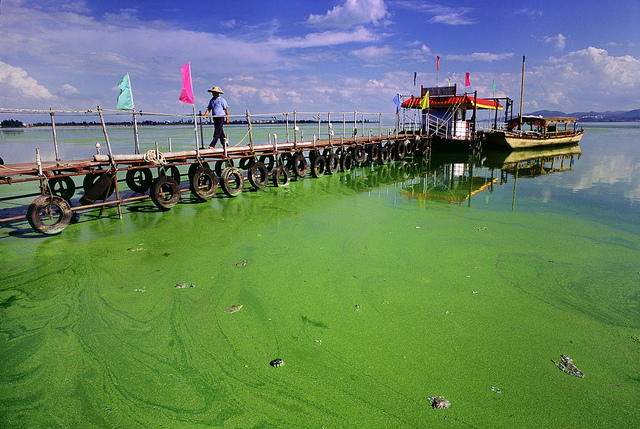
By Codi Kozacek
Circle of Blue
Decades of research and billions of dollars spent to understand the causes of toxic algae blooms and oxygen-starved aquatic dead zones around the world have produced more scientific knowledge but achieved few results to solve two of the most dangerous threats to the world’s oceans and fresh water reserves. In fact, according to a growing body of scientific evidence, the algae blooms and near shore ocean dead zones are growing larger, more numerous and endangering important fisheries and drinking water consumed by millions of people.
The studies and research findings, published in well respected journals like Science and supported by institutions like the U.S. National Science Foundation, show that algae blooms and dead zone are symptoms of the same global affliction: humans pouring more and more fertilizer, manure and wastewater into lakes, rivers and oceans. In August, a toxic bloom shut down the water supply system for Toledo, Ohio, one of the largest cities on the Great Lakes of the United States.
The Toledo emergency, the first time a toxic bloom closed a big American city’s drinking water plant, is the latest in a series of similar water shutoff incidents around the world over the last decade caused by toxic algae. A survey of news reports and scientific literature by Circle of Blue found that since 2004 blooms of toxic algae shut down water supplies for more than 3 million people on three continents and have closed hundreds of inland lakes to recreation. Prominent examples include:
- A toxic bloom on Australia’s Murray River in 2009 extended for more than 800 kilometers and prompted a “red alert” warning residents not to touch the water or drink untreated water.
- In 2007, more than 2 million people living in Wuxi, China, went without piped drinking water—some for longer than a week—after a bloom of the algae on Lake Taihu overwhelmed the city’s water plant.
- In 2004, a toxic algae bloom on Lake Victoria temporarily suspended water supplies for Kisumu, Kenya, home to nearly 500,000 people.
Dead zones, the low-oxygen areas that form when vast algal blooms die, decompose and force fish and other animals to either leave or perish, are also spreading. A 2008 study by the Virginia Institute of Marine Science found that there were more than 400 dead zones worldwide, covering a total of 245,000 square kilometers. Some of the largest and most problematic include the dead zone in northern Europe’s Baltic Sea and the dead zone in North America’s Gulf of Mexico, which supports a $US 2.8 billion fishery.
High Costs But No Steps
The costs of such pollution are great, stemming from lost seafood sales, higher drinking water treatment costs, livestock losses and lower tourism revenues. In the United States, algal blooms in coastal waters are estimated to cost the country $US 82 million each year, according to the National Oceanic and Atmospheric Administration. These costs are even higher in Australia, where algal blooms in lakes and rivers are estimated to cost between $US 160 million and $US 214 million annually. The economic cost of algal blooms in Greece, Italy and Spain is more than $US 385 million every year, according to the European Commission.
Both algal blooms and dead zones have been recognized as major problems since at least the 1970s. The cause—excess amounts of the nutrients nitrogen and phosphorus—has also been known for decades. The United States, Europe, Australia, China and other nations have since spent billions of dollars on research and remedies to nutrient pollution. China, for example, spent $US 1.58 billion to clean up Lake Taihu in the 1990s, and has pledged to spend an additional $US 14.5 billion. But global actions to address nutrient pollution have repeatedly fallen short due in large part to citizen indifference that has translated into a dearth of political will to regulate nutrient management in the commercial agriculture industry.
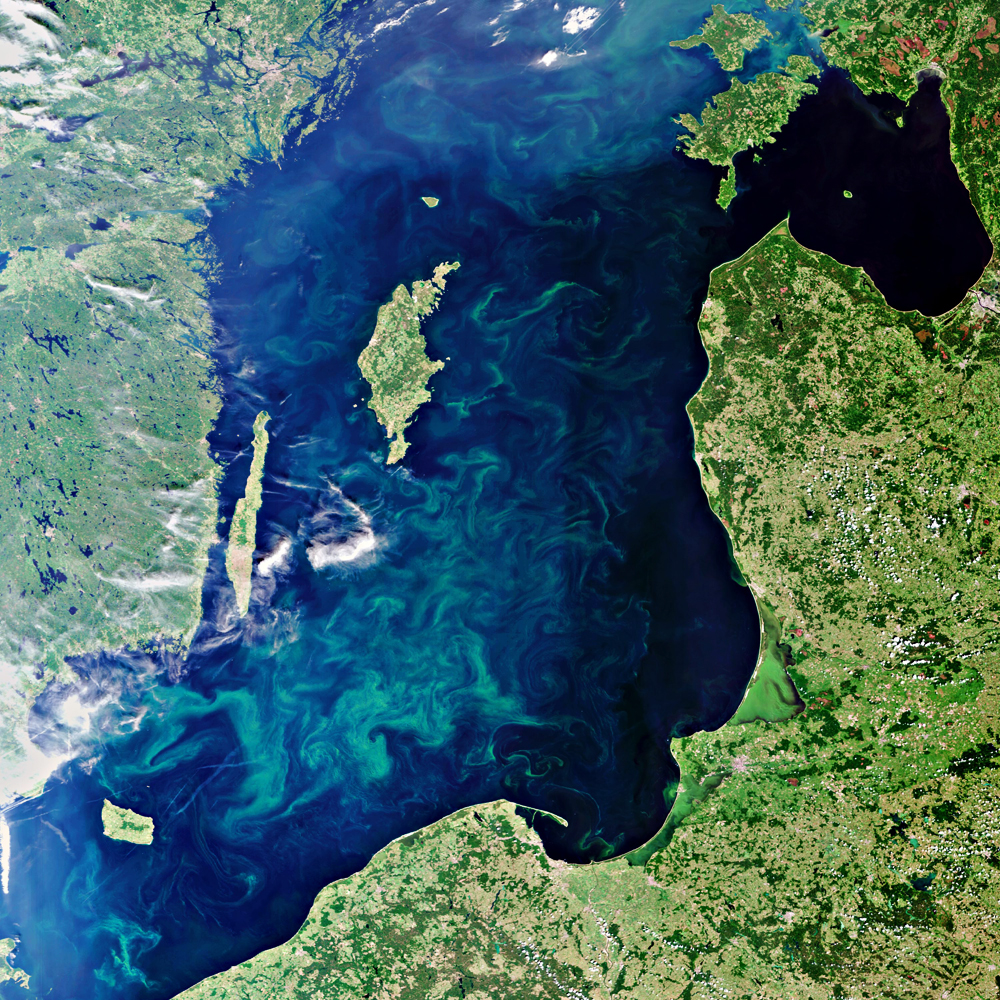
A prime example is the Gulf of Mexico dead zone, which spreads annually from the mouth of the Mississippi River as nutrients draining America’s heartland are washed to sea. Earlier this month the Inspector General Office of the United States Environmental Protection Agency released a report reiterating that the agency and its state counterparts are failing to do enough to reduce the size of the Gulf dead zone. The dead zone, which has been monitored since the 1970s, has not changed in size since the 1990s, and is three times as large as a goal set by a regional task force to reach 5,000 square kilometers by 2015—a goal the basin will fail to meet.
Even in Lake Erie, where toxic algal blooms were eradicated in the 1980s following reductions in nutrient pollution from wastewater treatment plants and factories—so-called point sources—prominent scientists warned that the problem could return if nonpoint sources of nutrients, like farms and lawns, were not addressed. The idea was dismissed.
“They said no, we invested enough money in the problem. We’ve signed an agreement now. We’ve declared that eutrophication will go away,” David Schindler, a scientist at the University of Alberta, told Circle of Blue. Dr. Schindler produced landmark experiments on Canadian lakes in the 1960s that identified phosphorus as the key driver of algae growth in fresh water. “Now, with increasing populations, we have used more and more fertilizer, grown more and more livestock on the land, and turned more and more natural ecosystems into concrete jungles, and all of those things have increased these nonpoint sources. The politicians can’t really claim that no one told them this was likely to happen.”
Efforts to Regulate Agriculture Stymied
Elected officials and organizations who try to regulate nonpoint source pollution, especially from agricultural sources, typically run up against stiff opposition. Before Toledo, the last major scare over toxic algae in the United States occurred in 1997 in the Chesapeake Bay region. The algae killed thousands of fish in the Pocomoe River, a tributary to the bay, and was linked with strange neurological conditions like temporary memory loss in people who touched the water. Though it was never shown to sicken people who ate seafood from the bay, widespread fear of the toxins functionally closed down Maryland’s $US 400 million seafood industry for several months. Grocery stores would not carry seafood, and restaurants stopped serving it.
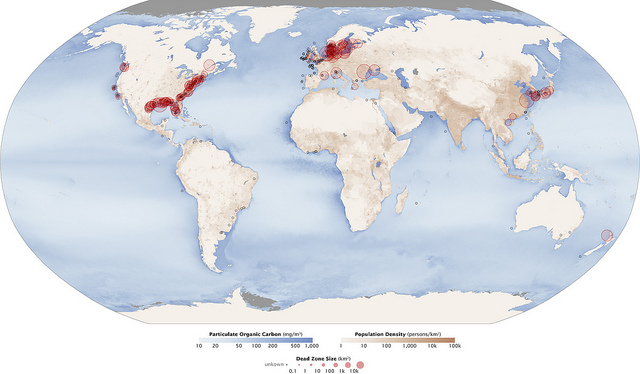
In the aftermath of the outbreak, Maryland Governor Parris Glendening and the state’s Democrats attempted to pass legislation targeting nutrient pollution from commercial poultry farms and other nonpoint sources. Very little made it through the state legislature.
“We did get some things through, but they were significantly weakened in the legislative process,” Glendening told Circle of Blue. “There were key committees in the legislature that it had to go through, and those were chaired by someone from the most rural area of our state. Because of the public outrage and such they knew they had to do something, but they passed a very weakened bill that had no real impact.”
The contamination of Toledo’s drinking water this summer produced a similar public outcry in Ohio for action on nutrient pollution and toxic algae blooms. In the past two months alone, more than $US 160 million has been pledged by state, federal and industry groups to address the problem. Legislative action on the issue in the past, however, has met the same fate as the laws Glendening championed in Maryland. A key nutrient management law passed by Ohio in January, for example, did not include manure as a fertilizer—a move that significantly weakened the law, according to state representative Teresa Fedor, a Democrat from Toledo.
“It’s so solvable it’s a no brainer. But you’re fighting the 13,000 lobbyists who are getting paid by corporate agriculture, which has a whole lot of money to throw around,” Fedor told Circle of Blue. “Twenty years is too long to be aware of something this harmful. It’s inexcusable and morally wrong for elected officials to continue allowing the poisoning of our waters because of big money. They have all these excuses saying no regulations, no regulations, no regulations. We need regulations on seatbelts for cars to save lives, and on air pollution to shut down acid rain. So why would we not do this for the most fundamental, basic need of water?”
An influx of money without regulation, however, has proven largely ineffective in both the Chesapeake Bay and the Gulf of Mexico. Though the Chesapeake Bay watershed has avoided a repeat of the devastating 1997 algae bloom, harmful algae still prompts recreational advisories on the region’s rivers, and feeds a dead zone in the bay each summer.
Reducing nutrient pollution and the dead zone is the focus of an initiative including six states and the federal government—the Chesapeake Bay Program—formed in 1983. State and federal governments spent nearly $US 3 billion on water quality improvement projects in the bay watershed between 2007 and 2010, the latest years for which data is available. Progress, however, has been patchy, and the Chesapeake Bay Program gives this assessment of its work on its website:
“After more than 25 years of restoration efforts, data generally show decreasing long-term pollution trends from the bay’s major rivers. Although that’s good news, a clean bay is the ultimate restoration measure. Some signs are positive, but other key indicators are lagging. Overall, the bay remains degraded, but Bay Program partners are working harder than ever to bring the estuary back to health.”

Research and Ineffective State Plans
A similar scenario has played out in the Gulf of Mexico, where the federal Clean Water Act’s limited ability to regulate agricultural runoff—responsible for 70 percent of the nitrogen and phosphorus nutrients creating problems in the Gulf—is a major reason there has been little improvement in the dead zone, according to a review released earlier this month by the U.S. Environmental Protection Agency’s Office of Inspector General.
The review assessed the progress of 12 states within the Mississippi River Basin to create nutrient management plans, as recommended by the task force in 2008. The management plans are the keystone of an action plan to make the 45 percent nutrient reduction. But the review found that most of the states are making little headway toward that goal. The deadline for final management plans was set for 2013, but only Illinois and Iowa have finalized their plans. Eight other states have draft plans. Arkansas and Tennessee have not created any plans.
Of the states that have created plans, just three—Iowa, Minnesota and Wisconsin—have set specific targets for nutrient reductions. Minnesota is the only state to set a timeline for accomplishing their nutrient reduction goals, aiming to cut nitrogen by 20 percent and phosphorus by 35 percent by 2025. The state, though, accounts for less than three percent of the nutrients flowing into the Gulf. Iowa is the only state to commit to reducing both nitrogen and phosphorus by 45 percent, but it has no timeline for this goal.
“This [report] follows on a very long and unfortunate history of EPA having delayed and put off the action that’s really necessary to deal with the huge problem that the country faces with algae in our waterways,” Ann Alexander, a Chicago-based senior attorney for the Natural Resources Defense Council, told Circle of Blue. “It follows an only slightly shorter history of the Inspector General having pushed them to do something about it.”
In 2009, a separate Inspector General report said the EPA needed to accelerate the creation of numeric water quality standards, which would outline the maximum amount of nutrients allowed by law in Mississippi River Basin waterways. The EPA has shied away from imposing such standards, instead encouraging states to reduce nutrients on their own, without federal intervention.
“The IG has been completely and justifiably after EPA on this issue for a long time,” Alexander said. “EPA has been pretty obstinate in not doing anything in response.”
While dead zones are relatively invisible and water treatment plants have typically been able to treat toxins created by algal blooms, the problems continue to spread as population growth, climate change and food production contribute to the glut of nutrients.
“I foresee, without being an alarmist, years when far more people than the 400,000 affected now will be looking around saying, why is no one doing anything?” Glendening said. “By that time it could likely be too late because there are things that you cannot put in place overnight.”
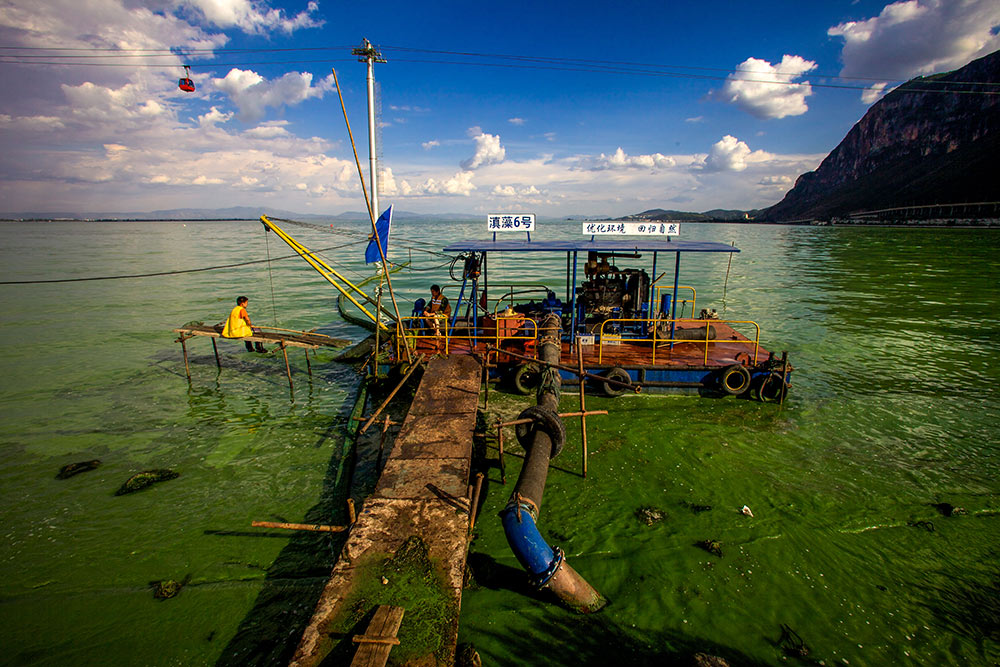
A Worst Case Scenario
In 2007, a massive bloom on China’s Lake Taihu—the third largest lake in the country—showed just how costly algae can be. Drinking water intakes for the city of Wuxi were overwhelmed as the toxic bloom stretched nearly across the entire 2,250-square-kilometer lake, leaving 2 million people without water.
“Overnight, the city had no drinking water,” Hans Paerl, a professor at the University of North Carolina-Chapel Hill who has done extensive work on the lake, told Circle of Blue. “What happened is folks woke up in the morning to make tea and found green Jello-like stuff coming out of the faucet.”
It took about a month to clean up the mess and fully restore drinking water service, forcing the Chinese government to deliver bottled water to residents in the meantime.
“Basically, we are using Lake Taihu as a looking glass for how bad things could get here,” Paerl said.
Paerl and his colleagues were engaged by China to help develop a plan to curb the algae, which has become an annual scourge on Lake Taihu. The lake supplies water to more than 10 million people around its shores, as well as for industrial and agricultural purposes.
The Taihu watershed has experienced rapid change during the past three decades, transforming from a predominantly rural region supporting less than 1 million people to an industrial center with a population topping 20 million. In addition, the region’s agricultural industry grew. As a result of the increasing wastewater from cities and fertilizer from farms, phosphorus and nitrogen inputs to the lake grew tremendously, Paerl said.
“Back in the early 90s, the lake had gone through a state change where the blooms initially started appearing but were not too serious,” he said. “Within a matter of five to 10 years, the lake shifted to a situation where blooms started to pop up in the spring and persist through the summer. The change is very extreme. Now, blooms start in early May and run all the way into November—more than half the year.”
To remedy the problem, Paerl and other researchers found that the amount of phosphorus and nitrogen making it into the lake will have to be reduced by at least 50 percent.
“The government is aggressively pursuing these reductions because Taihu is important nationally in China,” he said. “It is a revered lake. It sustains a large population in one of the most active, growing regions in China. It supports industry, tourism—there are huge amounts of resources and money involved.”
Sources of the nutrients in the Taihu basin are about equally split between point sources—such as wastewater treatment plants—and nonpoint sources like farms, according to Paerl. Efforts to reduce phosphorus and nitrogen are therefore targeting both types of sources. Wastewater plants, for example, are beginning to remove more phosphorus during the treatment process and some waste may even be transported out of the basin. Tackling nonpoint sources will involve reducing fertilizer applications, installing riparian buffers, and constructing wetlands. As much as a third of the nitrogen can also come into the lake via air pollution from cars, meaning this too will need to be addressed.
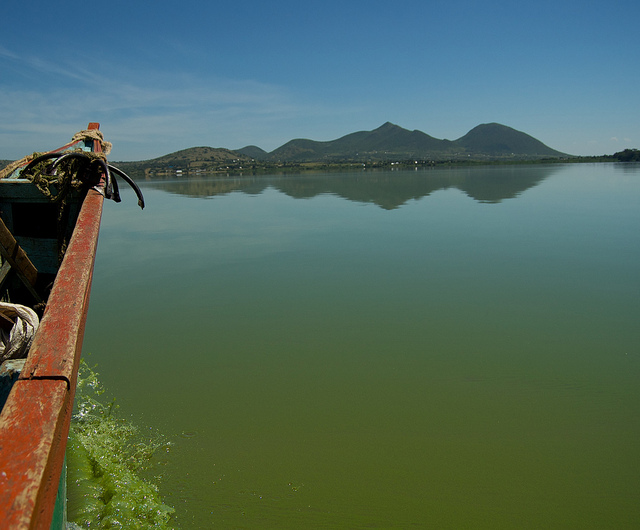
A news correspondent for Circle of Blue based out of Hawaii. She writes The Stream, Circle of Blue’s daily digest of international water news trends. Her interests include food security, ecology and the Great Lakes.
Contact Codi Kozacek



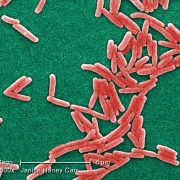

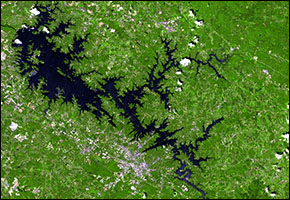




Horrible. I hate the algae and I hate earth. We should just nuke the entire planet so we can all die and then algae wouldn’t be a problem at all. DOWN WITH EARTHLINGS.
Excellent article. I am using this article in mt AP Environmental Science course for High School seniors and I wanted to thank you for the story and the work that you do.
Thank you, Cody, and Circle of Blue for your follow up global perspective to Lake Erie “Dead Zone” and Toledo, Ohio and Monroe County, Michigan drinking water shut-downs from toxic algal blooms. Increasingly, it is ever more apparent that the legal and policy framework to address the foot-dragging by special interests, like farming, is to focus on the integrity of water quality and quantity required by the public trust doctrine. Every country that can trace its water to public ownership or public sovereign ownership, or the public trust principles in western civil or common law, should apply an umbrella principle to every person and government. Navigable waters are held by government, as public trustee, of a public trust in the water, bottomlands, and fish and aquatic resources and habitat to protect drinking water, sustenance, health, bathing, swimming and other recreation, and fishing, shelling, and navigation. Any one who subordinates these fundamental principles or substantively impairs these public trust waters violates the public trust. This will allow every one to be subject to the same basic ancient and adopted principle. If we apply this, it will protect this commons when necessary, as now with nutrients, algal blooms, and climate change which exacerbates these conditions, and we will begin to make smart decisions for food, energy, and water, and ourselves, and economy which is fundamentally based on these public trust waters. This is why, I suggest, the International Joint Commission that governs boundary waters between US and Canada recommended public trust principles in its 2014 LEEP Report as the supplemental framework and principles to address algal blooms in Lake Erie and logically other Great Lakes.
Thanks Cody.
Are you aware of Phoslock’s water treatment product which locks up phosphorus on the bed of the water body thus eliminating blue-green algae? Although it is expensive it works very well. Their agent in the USA is SEAPro.
Great article Cody, thanks! The root cause would be the “excess nutrients” (i.e., phosphorous and nitrogen, and the ratio of the two). Seem like the Cisbay’s guys with their Bio-Pond product able to penetrate at the root caused and helping some of the biggest growers in the Central Valley, California save their reservoirs from the algae bloom that I ran across. I will continue to monitor their progress and hope anyone with the right contact to give them the right connection to the State level.
Well done. Thank you for the excellent overview. This is a very much appreciated synthesis on a vitally important set of water quality issues.
I very like your photos of the dead zones ruin water. Thank a lot for share.